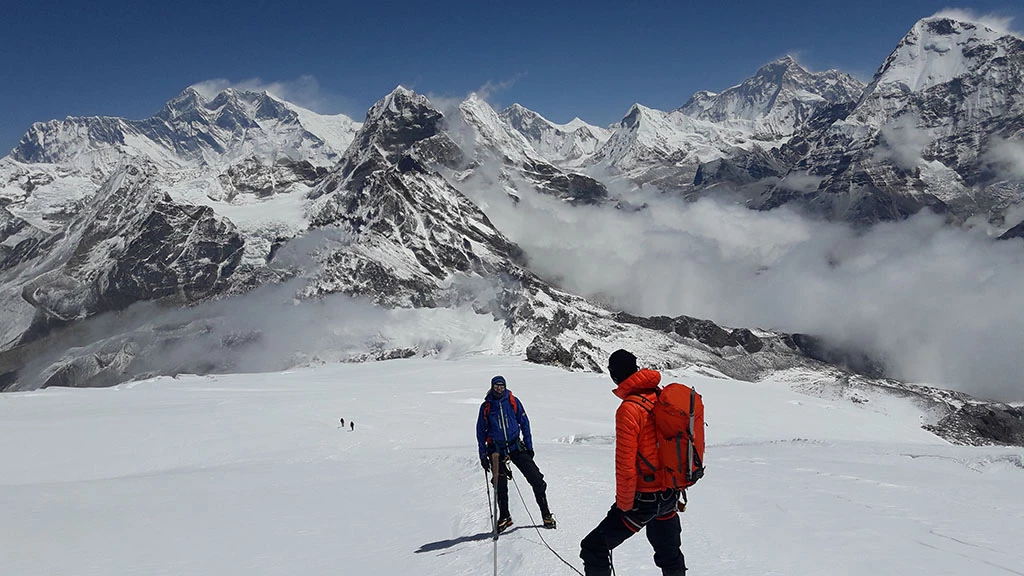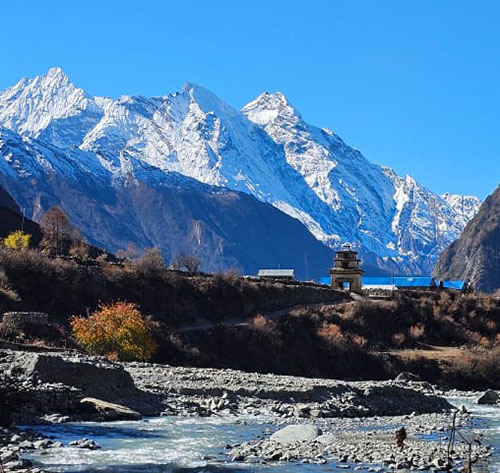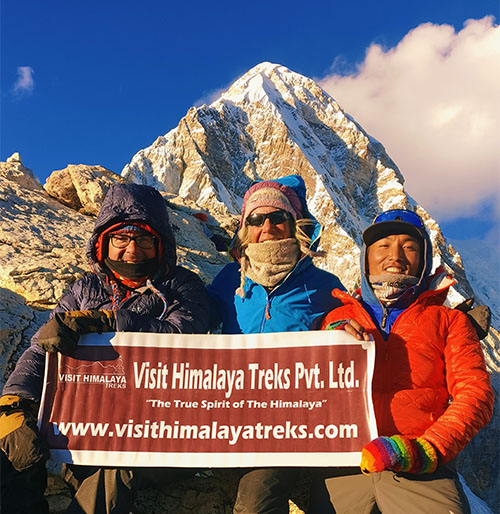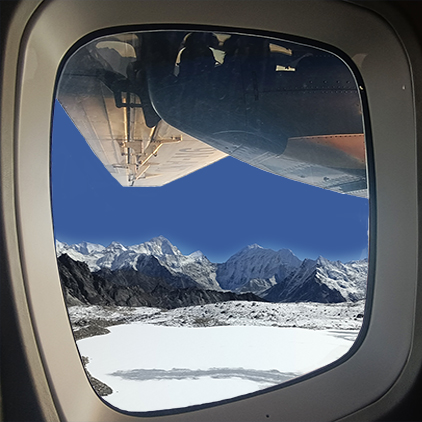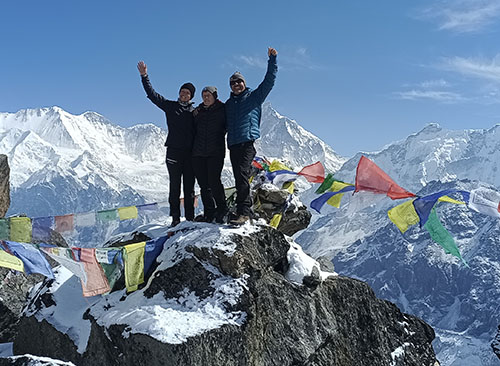The Most Popular Trekking Peaks in Nepal, Gain your Climbing Experience with Super Confidence.
Nepal is an amazing country, one of the world’s best destinations for various types of adventure sports and activities. Apart from major mountaineering expeditions and trekking, the most popular at present is climb of trekking peaks. Interested and energetic people can gain the climbing experience with great confidence climbing above and on less than 6,000-meter peaks.
Nepal is a land of great massifs, such as the Himalayan range, capturing the world’s eight highest peaks. Includes hundreds of peaks above and below 7,000 m and 6,000 meters to enjoy the spirits of mountaineering.
Most of Nepal's popular trekking peaks are governed by a semi-government organization, NMA (Nepal Mountaineering Association). For above or below 6,000 m/ 19,685 feet, a climbing permit is required to Climb various exciting trekking peaks from NMA.
Trekking and Peak Climbing are some of the most exciting adrenaline-to-moderate adventures to gain a lifetime experience. For all trekking peaks on booking with Visit Himalaya Treks, we will arrange and organize necessary itineraries with logistic support. As well as obtaining trekking and peak climbing permits as per your choice of trekking peaks.
Combine your Trekking Holidays in Nepal with climbing the most popular Trekking Peaks In Nepal.
Mera Peak Climbing Trip In Nepal.
Mera Peak Brief Profile:
Mera Peak height: 6,476 meters (21,247 ft)
Mode of Climbing: On the best available Tea House and Lodge and Tented Camping for a few days on Mera Peak climb.
Trekking Grade: Demanding to Extreme Grade.
Climbing Grade: F to PD (Facial East to Per Difficult) as per French / Swiss Alpine Climbing Classification Systems.
Trek & Climb Duration: 17 Nights and 18 days trek and climb only.
Trekking and Climbing Region: Nepal Far North Mid-East around Khumbu Himal.
Total trip duration: 21 nights and 22 days, arriving in Nepal to departure from Nepal.
Best Seasons for Mera Peak Trek & Climb: The best seasons for Mera Peak Climbing are spring, from March to May, and autumn, from September to November. One enjoys it during the winter time, December, January, and February also, but mornings and nights are cold with freezing temperatures during the winter time.
The Mera Peak Climbing itinerary and grading:
The itinerary days can be extended for more days, as per the client's interest, to allow more flexibility in walking and climbing. The grading systems can vary from others using USA or Scottish alpine climbing grades. But the most popular and widely used are the French and Swiss Alpine Climbing Classification Systems.
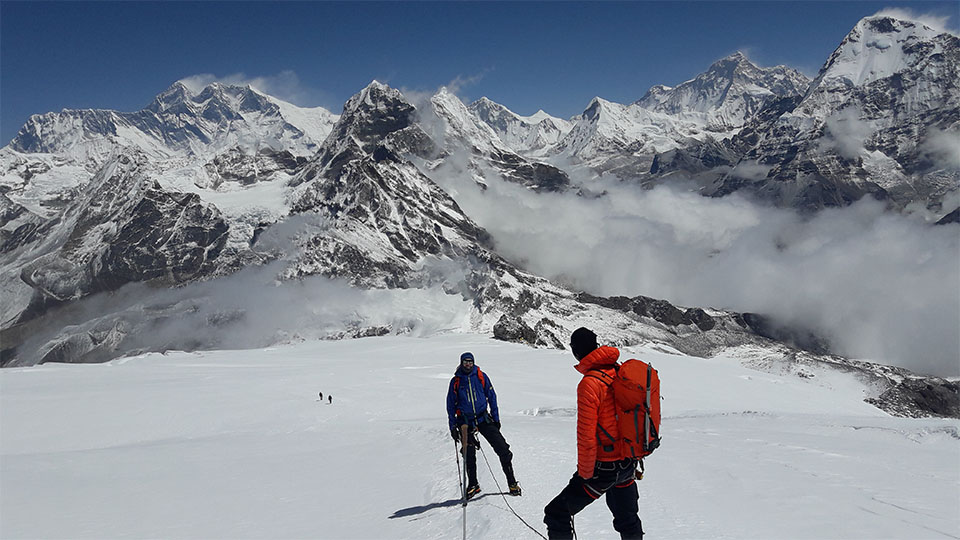
View from near Mera Peak Summit, Background views Everest, Lhotse, and Makalu from left to right.
The Mera Peak Climbing trip overview,
The 6476 meters / 21247 feet tall Mera Peak is one of the highest trekking peaks in the Nepal Himalayas and is located within the Khumbu area. The land of the famous Sherpa, the Highlanders of Everest, and the Eastern Himalayas. The walk starts and ends in Lukla Town after a short flight from Kathmandu. It is on the list of the NMA (Nepal Mountaineering Association), the governing body that controls most of the trekking peaks in Nepal.
From the Mera Peak Summit, there are visible panoramic views of Mt. Everest, Mt. Makalu, and as far as Kanchenjunga on the east horizon. Includes an array of giant peaks that encircles the summit of Mera Peak.
It is a straightforward climb with less technical skills, but it needs good climbing gear for a successful climb and safe descent. Suitable for all trekkers, from beginners to expert mountaineers and climbers. A Climbing Mera Peak should be in good physical shape and with a sound medical health background.
Island Peak Climbing Trip In Nepal
Brief Profile:
Island Peak (Imja Tse): 6189 meters (20,305 feet)
Mode of Climbing: On the best available Tea House and Lodge and Tented Camping on a climb from base camp for a couple of overnights.
Trekking Grade: Moderate and Adventurous.
Climbing Grade: PD + (Per Difficult with plus) as per French/Swiss Alpine Climbing Classification Systems.
Island Peak Trek & Climb Duration: 17 Nights and 18 days. From Lukla to Lukla.
Trekking and Climbing Region: Nepal Far North Mid-East around Khumbu Himal.
Total trip: 21 Nights and 22 Days from arrival to final departure.
Best Seasons for Island Climbing In Nepal: The best seasons for Island Peak Climb are spring and autumn/fall. But one can enjoy it during winter time also, but morning and night are much cold with freezing temperatures.
Island Peak Climbing itinerary and grading:
The itinerary days can be extended for more days, as per the interest of clients to allow more flexibility on walks and climbs. The itinerary days include a visit to the famous Everest base camp, with a climb of Kalapathar rocky hill. A popular viewpoint for the closest grand views of Mt. Everest Including the Everest base camp and Kala Patthar supports good acclimatization before the climb to the Island Peak summit.
The grading systems can vary from others, using USA or Scottish alpine climbing grades. But the most popular and widely used are the French and Swiss Alpine Climbing Classification Systems.
Island Peak Climbing Trip In Nepal
EBC Trekking with Combining with Island Peak Climbing is One of the most popular trekking and Climbing in the Nepal Himalayas, due to its easy accessibility from the main trekking trails. Where one can enjoy the comfort of a nice cozy lodge, with only a few overnights in a tented camp on climbs. Island Peak towers high amidst scenic Imjatse Valley near Dingboche and Chukung settlements. Island Peak is also called Imjatse Himal due to its location, as listed in NMA as a trekking peak.
Towers at 6,189 m / 20, 305 feet high, which is perfect for beginners as well as for veteran mountaineers. The summit of Island Peak rewards panoramic views of Mt. Everest, Mt. Lhotse, Nuptse, and Ama Dablam. As far as Mt. Makalu with an array of giant peaks that encircles the top of Island Peak summit.
Island Peak, is a climb with a straightforward route with some technical difficult sections to negotiate. Climbers need good climbing gear for successful climbs and safe descents, a supporting and main rope will be fixed. A perfect peak for beginners and expert climbers, from above 18 to 65 years of age. But should be in good physical shape and with a sound medical health background.
Lobuche East Climbing Trip In Nepal.
Brief Profile:
Lobuche Peak Height: 6,119 m/20,070 feet.
Mode of Climbing: On the best available Tea House and Lodge and Tented Camping on a climb from base camp for a few overnights.
Trekking Grade: Moderate and Adventurous.
Climbing Grade: TD (Technical Difficulty ) as per French / Swiss Alpine Climbing Classification Systems.
Trek & Climb Duration: 15 Nights and 16 days. From Lukla to Lukla.
Trekking and Climbing Region: Nepal Far North Mid-East around Khumbu Himal.
Total trip: 19 Nights and 20 Days from arrival to final departure.
Best Seasons for Lobuche East Climbing:
The best seasons for Lobuche East Peak Climb are spring and autumn/fall. One can enjoy it during winter time also, but mornings and nights are much colder with freezing temperatures.
Lobuche East Climbing itinerary and grading:
The itinerary days can be extended for more days, as per the interest of clients to allow more flexibility on walks and climbs. The itinerary days include a visit to the famous Everest base camp, with a climb of Kala Patthar viewpoint.
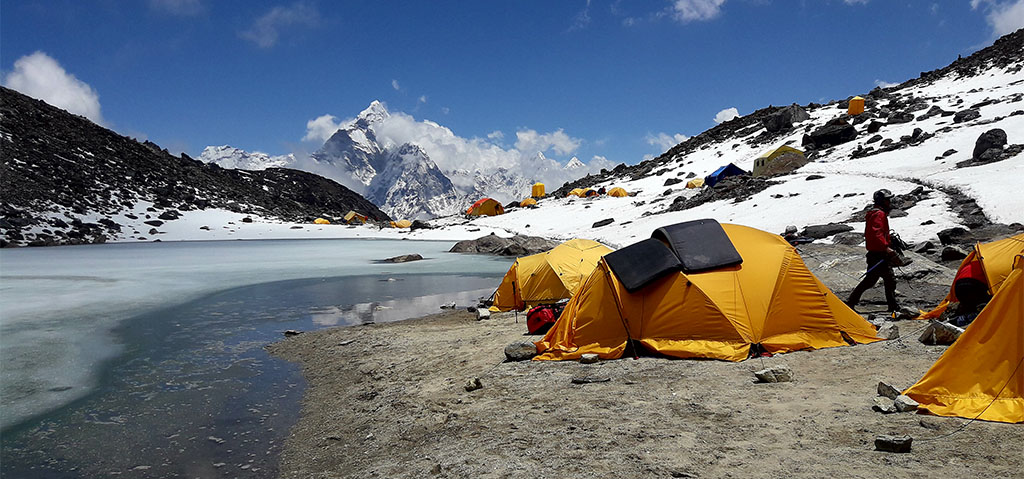
Lobuche Peak High Camp.
Lobuche East Climbing Trip In Nepal.
Lobuche East Climbing is an adventure around the high Khumbu Valley a mere distance from the famous Everest base camp. As well as close en route from the main routes of Dingboche, Pheriche, and Lobuche settlements. However, the base of Lobuche East Peak is well hidden away from the main trekking trail.
Lobuche East Peak towers high at 6,119 m/20,070 feet above the picturesque Khumbu Valley. In the past few decades, it has gained more climbers for the climb to Lobuche East Peak.
Everest Base Camp Trek with Lobuche Peak Climbing Trip led to a great adventure visiting the high Khumbu Valley close to Mt. Everest. The Lobuche with two twin peaks West and East, the West peak of Lobuche is slightly higher and least climbed. Lobuche East is a significant peak, for all trekkers and climbers to enjoy the great feat taking the daring challenges. To reach the summit of Lobuche East Peak for every hard effort, rewards with mind-blowing views.
Enjoy the glory of success overlooking spectacular views of Everest, Lhotse, Nuptse, and Ama Dablam with Cholatse, Pumori, and other closer peaks. After an exciting moment, descend to base camp for an onward journey back to Lukla.
Lobuche East Peak, although a tough mountain to climb, all can enjoy it with the guidance of our expert climbing guide A perfect peak for beginners and expert climbers from above 18 to 65 years of age. But should be in good physical shape and with a sound medical health background.
Nirekha Peak Climbing Trip In Nepal.
Brief Profile:
Nirekha Peak Height: 6,159 m/20,207 feet.
Mode of Climbing: On the best available Tea House and Lodge and Tented Camping on the climb after Dragnak at the end of Gokyo Valley and from Nirekha Peak base camp for a few overnights.
Trekking Grade: Moderate and Adventurous.
Climbing Grade: PD + (Per Difficulty and) as per French / Swiss Alpine Climbing Classification Systems.
Trek & Climb Duration: 21 Nights and 22 days. From Lukla to Lukla.
Trekking and Climbing Region: Nepal Far North Mid-East around Khumbu Himal.
Total trip: 25 Nights and 26 Days from arrival to final departure.
Best Seasons for Nirekha Peak Climbing In Nepal: The best seasons for the Nirekha Peak Climb are spring and autumn/fall. But one enjoys it during winter time also, but morning and night are much cold with freezing temperatures.
Nirekha Peak Climbing itinerary and grading:
The itinerary days can be extended for more days, as per the interest of clients to allow more flexibility on walks and climbs. The itinerary days include a visit to the picturesque Gokyo Valley of beautiful glacial lakes. As well Nepal Himalayan's longest Ngozumpa Glaciers the glacial source of the Dudh Koshi River.
The adventure includes Chola Pass and Everest base camp, with a climb of Kala Patthar viewpoint after the Nirekha Peak Climbing trip. Including a climb to high Gokyo-Ri with superb views of the world’s four highest peaks, Everest, Lhotse, and Cho-Oyu with Mt. Makalu. The climb to Gokyo-Ri supports good acclimatization before the climb to Nirekha Peak.
Nirekha Peak Climbing Trip In Nepal.
The climb Nirekha Peak summit, with the option of two routes either walk to Gokyo Valley of Lakes. Then climb to the high Cho-La Pass at 5,420 m to reach Nirekha Peak Base Camp at above 5,000 m. The other options are first visiting Everest Base Camp and climbing Kala Patthar hill.
Then continue the walk past Lobuche to Dzongla and climb to Cho-La Pass towards Nirekha base camp. After the climb return journey via Gokyo Lake on the main trail to Namche Bazaar and Lukla. Most itineraries are designed first by visiting Gokyo Lake and then towards Nirekha Base Camp via Cho-La Pass. Nevertheless, Nirekha Peak is a magnificent trekking peak at 6,159 m/20,207 feet high.
As listed in the NMA group of trekking peaks located around remote and isolated pockets of upper Khumbu Valley. Which is close to Lobuche East and West Peaks, north of Cholatse Peak and from Cho-La Pass.
Nirekha Peak is one of the least climbed trekking peaks due to its remoteness and well hidden; from the main trail of Gokyo and Everest Base Camp. But slowly getting a few groups of climbers in every good season of the year. For trekkers and climbers interested in venturing around off the beaten tracks to Cho-La Pass, and Nirekha Peak base camp. The climb of Nirekha Peak is a straightforward route to the summit. Few technical sections require good knowledge of climbing equipment.
However, with the guidance of our expert guide reaching on top of Nirekha Peak summit. Enjoy the jaw-dropping scenic panorama of a series of towering peaks with views of Mt. Everest, Lhotse, and Nuptse. Includes views as far as towards Cho-Oyu and Gyachung Kang with Cholatse and Lobuche East and West Peaks.
Pachermo Peak Climbing In Nepal.
Brief Profile:
Phachermo Peak Height: 6,273 meters (20,574 feet)
Mode of Climbing: On the best available Tea House and Lodge, overnight most of the trip in Tented Camping on leaving Kathmandu. On reaching the Khumbu region in a nice lodge from Thame, Namche to Lukla.
Trekking Grade: Moderate, Adventurous to Demanding.
Climbing Grade: PD (Per Difficult ) as per French / Swiss Alpine Climbing Classification Systems.
Trek & Climb Duration: 12 Nights and 13 days starting from Lukla to ending at Lukla.
Trekking and Climbing Region: Nepal Far North Mid-East around Rolwaling Valley & Khumbu Region of Everest.
Total trip: 16 Nights and 17 Days from arrival to final departure.
Best Seasons for Pachermo Peak Climbing: The best seasons for Pachermo Peak Climb are spring and autumn/fall. September to December in the autumn season and March to May in the Spring season.
Pachermo Peak Climbing itinerary and grading:
The itinerary days can be extended for more days, as per the interest of clients to allow more flexibility on walks and climbs. The itinerary days include trekking around the picturesque Rolwaling Valley enclosed by towering peaks. The adventure includes a tough climb to the high Tashi Labtsa-La Pass 5,755 m/ 18, 881 feet. Before the Climb to Pachermo Peak . The climb to Tashi Labtsa-La supports good acclimatization before the climb to Pachermo Peak.
Larke Peak Climbing Trip In Nepal
Brief Profile:
Larkya Peak Height: 6, 249 m/20, 502 feet.
Mode of Climbing: On the best available Tea House and Lodge, overnights in Tented Camping at base camp till the climb is over.
Trekking Grade: Moderate to Adventurous.
Climbing Grade: TD (Technical Difficulty ) as per French / Swiss Alpine Climbing Classification Systems.
Trek & Climb Duration: 17 Nights and 18 days. Journey starting from Kathmandu to ending at Kathmandu.
Trekking and Climbing Region: Nepal Far North Mid-West, between Manaslu and Annapurna region of Nepal.
Total trip: 21 Nights and 22 Days from arrival to final departure.
Best Seasons for Larke Peak Climbing In Nepal.
The best seasons for Larke Peak Climbing are spring and autumn/fall. The Autumn season is from September to December and the Spring season March to May.
Larkya Peak Climbing itinerary and grading:
The itinerary days can be extended for more days, as per the interest of clients to allow more flexibility on walks and climbs. The itinerary days include trekking around the picturesque Manaslu Region enclosed by towering peaks. The adventure includes a tough climb to high Larke-La Pass after a successful Climb of Larke Peak. The adventure to Larke Peak with good logical supports and acclimatization before the climb of Larke Peak.
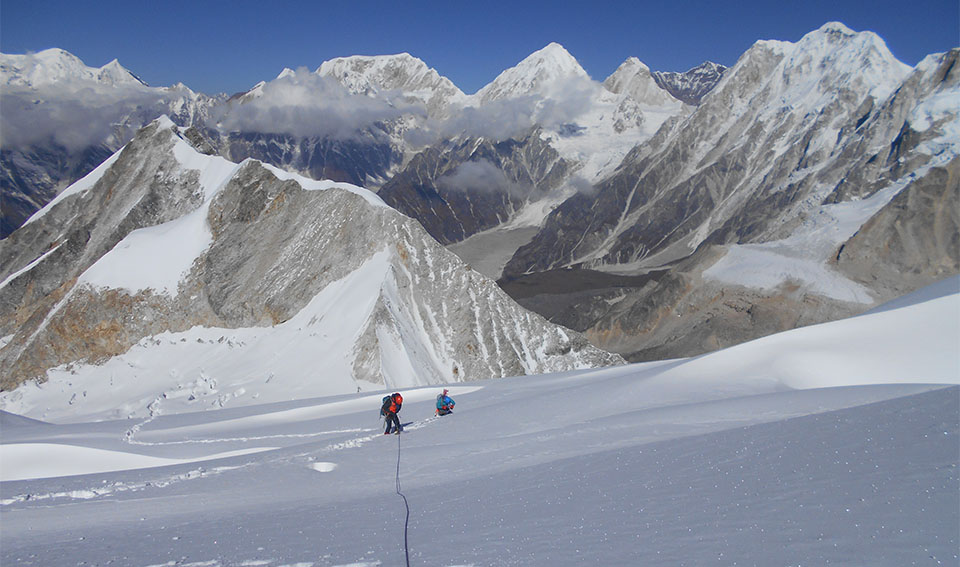
Panoramic Himalayan views are seen en route to Larkya Peak Climbing.
Larke Peak Climbing In Nepal.
Larke Peak Climbing leads toward a dramatic change in landscapes, climate, vegetation, and cultures. As well as constant views of towering snow-capped peaks of the Ganesh and Manaslu Himal ranges. The walk leads to steep ups and crossing exciting bridges to enter the Restricted Areas to Upper scenic Manaslu Valley. Jagat onward a strong heritage of Buddhist religions through a lovely village of Philim, Dyang, Namrung, to Lo-Gaon.
Then reaches the wide and picturesque Manaslu Valley in the close shadow of the Manaslu Himalayan range. Reaching Sama-Gaon, the main village of Upper Gorkha district and Manaslu Valley, then heading towards the end of the valley rim. Where the base of Larke La Pass is located, then heading to the main destination at Larke Peak base camp.
The Larke Peak is a challenging peak to reach the summit, with few tough technical sections to tackle. After good preparation and adding one more high camp to make the climb easier, safe, and approachable. Reaching on top after a vigorous haul to the summit enjoy the glorious panorama of staggering peaks. The views from Larke Peak summit at 6, 249 m/20, 502 feet. Facing the Manaslu Himalayan range with peaks of Annapurna, Himlung, and Damodar Himal, as far as Ganesh Himal.
After a successful ascent on top of Larkya Peak, one of the technically difficult mountains to gain experience in mountaineering. Return route downhill towards Manang district with an exciting climb over Larke-La Pass.
Pisang Peak Climbing In Nepal.
Brief Profile:
Pisang Peak Height: 6091 meters / 19,983 feet.
Mode of Trekking: On the best available Lodges and tented camping from Pisang village to base camp until the climb is over.
Trekking Grade: Moderate to Adventurous and challenging (in snow conditions).
Climbing Grade: PD + (Per Difficulty) from French & Swiss Alpine climbing classification.
Trek & Climb: 13 Nights 14 Days (with drive and flight from Jomsom to Pokhara).
Trekking and Climbing Region: Nepal Far North Mid-West around Manang and ends at Jomsom Mustang district.
Total Trip: 17 nights and 18 days (Kathmandu to Kathmandu)
Best Seasons for Pisang Peak Climbing: The best seasons for Pisang Peak Climb are spring and autumn/fall.
Pisang Peak itinerary and grading:
The itinerary days can be extended for more days, as per the interest of clients to allow more flexibility on walks and climbs. The itinerary days include trekking around the picturesque Manang Valley enclosed by towering peaks. The adventure includes a tough climb to the high Thorang-La Pass 5,416 m/17,769 feet. After a successful climb of Pisang Peak.
The grading systems can vary from others, using USA or Scottish alpine climbing grades. But the most popular and widely used are the French and Swiss Alpine Climbing Classification Systems.
Pisang Peak Climbing Trip In Nepal.
Pisang Peak Climbing adventure reaches you on top of 6,091 m and 19,984 feet. High above scenic Manang Valley, located North of the massive Annapurna Himalayas range of giant peaks. As well as close to Damodar Himal towards North Mid-West Nepal Himalaya. A fabulous adventure to Pisang Peak Climbing following the famous and popular Annapurna Circuit Trekking trail.
After the climb of Pisang Peak towards Mustang areas at Jomsom town via Thorang-La pass. Pisang Peak stands aloof as individual peaks within the same ridges as Chulu’s group of peaks. High above North East of Manang Valley and Annapurna range of peaks. Views of Pisang peaks, seen on entering the Manang Valley at Pisang Village after walking from Chame Town.
The climb starts over a moraine of rocks, snow, and ice, although a straightforward route, with few technical sections to negotiate. Setting base and high camps then reach on top of Pisang Peak summit, a lofty and dome-shaped Pisang Peak. After a successful climb either walk or drive on the same route back to Kathmandu via Bhesishar. The other options crossing Thorang-La Pass to reach Muktinath and Jomsom Town in the Mustang area. Then fly to Pokhara to reach back to Kathmandu, after a great experience on the Pisang Peak Climbing adventure.
Chulu East Peak Climbing Trip Nepal
Brief Profile:
Chulu East Peak Height: 6,584 m / 21,727 feet.
Mode of Trekking: On the best available Lodges and tented camping from Pisang village to Chulu East base camp, until the climb is over.
Trekking Grade: Moderate to Adventurous and challenging (in snow conditions).
Climbing Grade: PD + (Per Difficulty) from French & Swiss Alpine climbing classification.
Trek & Climb: 18 Nights 19 Days (with drive and flight from Jomsom to Pokhara).
Trekking and Climbing Region: Nepal Far North Mid-West around Manang and ends at Muktinath district in Jomsom.
Total Trip: 23 Nights and 24 Days (Kathmandu to Kathmandu)
Best Seasons for Chulu East Peak Climbing: The best seasons for Chulu East Peak Climbing are spring and autumn/fall.
Chulu East Peak Climbing itinerary and grading:
The itinerary days can be extended for more days, as per the interest of clients to allow more flexibility on walks and climbs. The itinerary days include trekking around the picturesque Manang Valley enclosed by towering peaks. The adventure includes a tough climb to the high Thorang-La Pass 5,416 m/17,769 feet. After a successful climb of Chulu East Peak.
The grading systems can vary from others, using USA or Scottish alpine climbing grades. But the most popular and widely used are the French and Swiss Alpine Climbing Classification Systems.
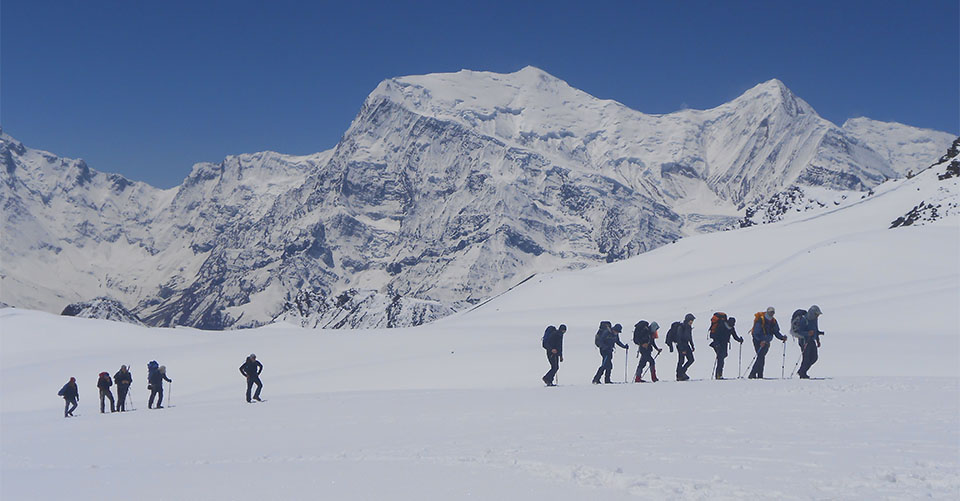
Chulu Far East Peak Climbing, en route to High Camp.
Chulu Far East Peak Climbing In Nepal.
Chulu East Peak stands high at 6,584 m / 21,727 feet, the highest trekking peak in the Nepal Himalayas. Located above scenic Manang Valley within its groups of Chulus range with Chulu West, Central, and Far East Chulu. Chulu East Peak was first ascent by a Japanese mountaineer Masataka Takagi in 1952, from then on it is often climbed. In the past few decades, the Chulu East Peak has become more popular, among trekkers and mountaineers. Besides being the tallest trekking peak, as well as for its exciting challenges to experience great mountaineering skills.
Chulu East Peak Climbing Trip starts with drives and treks from Dharapani village in Manang, following the famous Annapurna Circuit Trekking route. The route diverts from Pisang Village, leaving the main trail of Annapurna Circuit towards sheer mountain wilderness. Away from villages and human settlements to reach the base of Chulu East Peak.
The area is enclosed by the towering peaks of Chulu West and Central Chulus. Setting the base camp at 5,300 m, having time for acclimatization and practice climbing, then adding a high camp. The climb leads towards steep ridges of ice and snow and then reaches across rocky and technical sections to reach the top.
Standing on the summit of Chulu East Peak, enjoy the glorious panorama of surrounding arrays of snow-capped peaks. After achieving a successful ascent, the walk follows down to Manang Valley. Following the main route to Thorang-La Pass and then reaching Mustang district at Jomsom. A short scenic flight brings you to beautiful Pokhara, near Phewa Lake, to complete the Chulu East Peak Climbing adventure.
Bokta Peak Climbing In Nepal.
Brief Profile:
Boat Peak Height: 6,142 m/20,151 feet.
Mode of Trekking: In local lodges where available and tented camping.
Grade of Trekking: Moderate to Adventurous walks.
Climbing Grade: TD (Technical Difficulty to Challenge) from French & Swiss Alpine climbing classification.
Trek & Climb Duration: 22 Nights/23 Days with flights and drives both ways. (excluding trek to North Base Camp) Walking back to and from the nearest road-head, after Suketar.
Trekking and Climbing Region: Nepal Far Eastern Himalaya around Taplejung district, Kanchenjunga area.
Total Trip: 25 Nights and 26 Days from main arrival to departure.
Best Seasons for Bokta Peak Climbing: The best seasons for Bokta Peak Climbing are spring and autumn/fall.
Bokta Peak Climbing itinerary and grading:
The itinerary days can be extended for more days, as per the interest of clients to allow more flexibility on walks and climbs. The itinerary days include flights and drive to reach the starting point of treks. Bokta Peak Climb is around and near Kanchenjunga South Base Camp. The itinerary includes visits to the upper north base camp of Kanchenjunga at Pang-Pema and Lhonak.
After a successful climb of Bokta Peak return journey on the scenic route to Suketar at Taplejung town. For the drive back to Bhadrapur airport, then flying back to Kathmandu. The grading systems can vary from others, using USA or Scottish alpine climbing grades. But the most popular and widely used is the French and Swiss Alpine Climbing Classification Systems.
Bokta Peak Climbing In Nepal.
Bokta Peak is located in Nepal's Far Eastern Himalayas, around the world's third-highest peak Mt. Kanchenjunga. The trek and climb to Bokta Peak lead towards Mt. Kanchenjunga South Base Camp after visiting Kanchenjunga North Base Camp. The route is relatively frequented thus exploring traditional mountain villages and pristine surroundings. An interesting country to explore without the distractions of trekkers, as the area is least visited due to its remote location.
Bokta Peak at 6,142 m/20,151 feet, is located in one of the most remote and isolated trekking peaks in Nepal. Situated around Kanchenjunga Himalaya, a rarely climbed peak due to its remoteness. The Bokta Peak Climbing Trip includes a trek to Kanchenjunga North and South Base Camp as acclimatization walks and exercise. The newly opened peak listed in NMA in the “A” category, is merely above 6,142 m. Bokta Peak is a challenging and technical climb to its summit.
Good physical fitness and technical skills are required to reach the Bokta Peak summit. From the top offers breathtaking views of the Eastern Himalayas with massif peaks of Mt. Kanchenjunga 8,586 m. Including a view of the Kumbhakarna Himal range with (Jannu Himal 7,710 m) Phole 6,645m, Kabru 6,332m, and a chain of peaks.
Yala Peak Climbing Trip In Nepal.
Brief Profile:
Yala Peak Height: 5,500 m (18,000 ft)
Mode of Trekking: On the best available Lodges and tented camping from base camp until the climb is over.
Trekking Grade: Moderate to Adventurous.
Climbing Grade: F (Facial Easy without any Technical Difficulties) from French & Swiss Alpine climbing classification.
Trek & Climb: 11 Nights &12 Days (with drives both ways).
Trekking and Climbing Region: Nepal Central Himalayas around Langtang Valley within Rasuwa district.
Total Trip: 11 Nights 12 Days (Kathmandu to Kathmandu)
Best Seasons for Yala Peak Climbing: The best seasons for Yala Peak Climbing are spring and autumn/fall.
Yala Peak Climbing itinerary and grading:
The itinerary days can be extended for more days, as per the interest of clients to allow more flexibility on walks and climbs. The itinerary days include trekking around the picturesque Langtang Valley enclosed by towering peaks. The adventure includes acclimatization days with a climb to the high viewpoints of Tserko or Kyanjin-Ri, before the Climb of Yala Peak.
The grading systems can vary from others, using USA or Scottish alpine climbing grades. But the most popular and widely used is the French and Swiss Alpine Climbing Classification Systems.
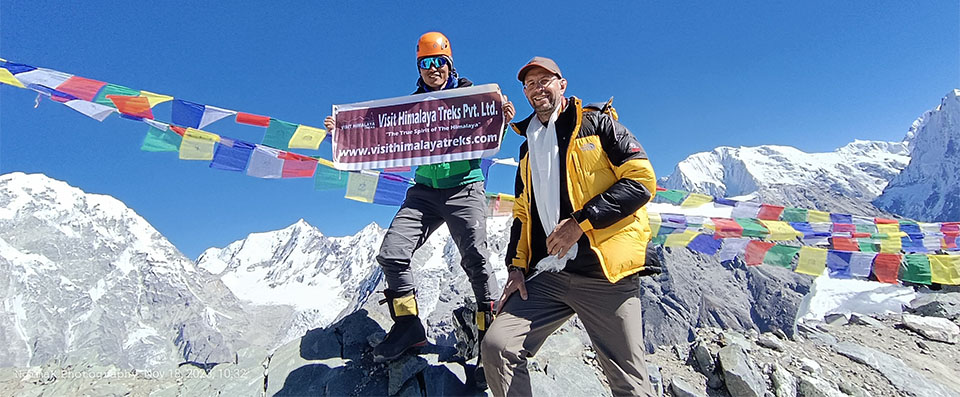
At Yala Peak Summit 5500 meters.
Yala Peak Climbing In Nepal
Yala Peak Climbing takes you to beautiful Langtang Valley, which is enclosed by an array of towering peaks of Langtang Himal. The climb of Yala Peak starts and ends at Syabrubesi Village, with drives from Kathmandu both ways. The walk leads to the last settlement at Kyanjin Gompa for overnight stops and rest days for acclimatization. From Kyanjin Gompa, the adventure begins heading further east at the near end of Langtang valley rim to Yala Peak base camp.
Having time for preparation and spending overnight in tented camping, then getting ready for the exciting thrill and climb. The climb starts, toward the summit of Yala Peak at above 5,500 m/18044. feet high. Although a lesser peak, below 6,000 m, allows the trekkers to experience the high altitude. As well as good practices and exercise for all people with an interest in mountaineering. One of the few peaks of less technical challenge to encounter, except for the long and strenuous steep climb.
From the top of Yala Peak Summit rewards spectacular views of surrounding giant snow-capped peaks. Including a panorama of Ghengu Liru (Langtang II 6,571 m / 21,560 feet), and Langtang Lirung (7,425 m / 23,765 feet). Includes Kim shun (6,745 m / 22,137 feet) with Shalbachum (6,918 m / 22, 699 feet) and towards the south. Overlooking, the views of Chimsedang high ridge with Naya-Kanga 5,846 m or Ganjala Himal with Gangchenpo and Tillman’s beautiful Fluted Peak.
The view extends towards Jugal Himal in the east and ends at Dorje Lakpa (6,966 m / 22,854 feet. As well as views of high peaks across the border of Tibet.
Strong Supporters team and Experience Climbing Guide.
In all our regular and moderate to higher grade adventures and on peak climbing. Supported and accompanied by Visit Himal Treks expert guides and staff in making every trip a success. The guides have full knowledge of the areas of all trekking peaks, from cultures to the various routes of the summit.
Backed by professional camping staff and cooks on climbs, as well as areas where the lodges are not available. All guides of Visit Himalaya Treks have gone mountaineering training with a license approved and Registered with NMA (Nepal Mountaineering Association).
The required fitness level and skills for Peak Climbing in Nepal.
All participants in treks and climbs for trekking peaks should be physically fit and in good medical health. If someone has any medical past background has to be informed by the guide and company on booking. So that the staff can take special care throughout the climbing and trekking. For the climb of trekking peaks, all can enjoy from beginners and expert climbers to mountaineers.
Climbing equipment list for all major trekking peaks:
|
Trekking Pole
|
Sleeping Bag
|
Rucksack
|
Trail Boots
|
|
Camp Shoes
|
Smartwool Socks
|
Gloves
|
Low Gaiters
|
|
Underwear
|
Sports Bra (women)
|
Sunglasses
|
Bandana
|
|
Hiking Hat
|
Wool Cap
|
Base Layer Top
|
Shoer Sleeves Shirt
|
|
Long Sleeves Shirt
|
Insulating Jacket
|
Rain/Wind Jacket
|
Shorts
|
|
Base Layer Bottom
|
Hiking Pants
|
Rain/Wind Trousers
|
Toothbrush/Paste
|
|
Sunscreen Creams/ Lip Balm
|
Toilet Paper
|
Towel
|
Water Bottle
|
|
Personal Size First-Aid Kit
|
Camera
|
Razor
|
Head Lamp
|
|
Pocket Knife
|
Durable Wallet/pouch for Money and Important Documents
|
Water purification Iodine tablet
|
Portable Charging Powers
|
Peak Climbing Gears Hiring Option.
For Trekking Peak Climbing Gears, one can bring from home. But if it is too much to carry, and can hire or rent in Kathmandu and also en route Khumbu areas. Like in Namche Bazaar and Chukung for Nirekha, Island and Lobuche East Peak. For the other region, it should be bought or hired the charge includes, from the date of hiring till return, should be in good condition. If damaged, lost should pay the full price of the items.
In Kathmandu, around the Thamel areas, there are many good shops and stores for trekking and climbing gear. On sale as well for hiring as per one’s interest and types of peaks and duration of the climbing itineraries.
Trekking Peak Climbing Conclusion.
Trekking Peak Climbing, besides other various adventures, peak climbing is one of the major sports activities. Nepal is a perfect country to learn and gain experiences enjoying climbing various trekking peaks. Nepal is a premier country for all types of sports, from rock or ice climbing to major mountains. Trekking peaks in Nepal allow interested adventurers to learn and experience the skills in mountaineering.
Trekking Peaks is for all people, from beginners in mountaineering to expert and veteran climbers. Various and different altitudes of peaks, from below and above 6,000-meter peaks to enjoy. We Visit Himalaya Treks ready to host your mountain adventure trips in the Himalayas of Nepal. Please do contact us for your Trekking, Tours, Peak Climbing Cultural Tours, and Luxury Holidays in Nepal.

